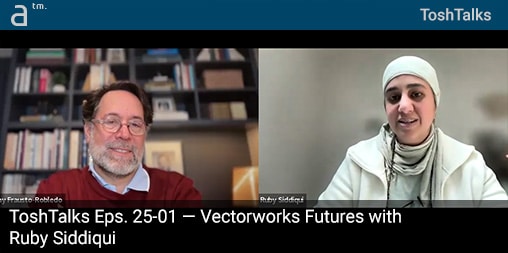WELCOME TO ARCHITOSH’S NEW SERIES ‘ToshTalks,’ a new video interview series with AEC software executives and product managers and leading firms and their digital design directors and leadership. We have a new Architosh Official YouTube channel—please go subscribe!—but you can find this video episode below in full.
Episode 1
Episode 25-01 (launch episode takes us on a fireside chat with Ruby Siddiqui as we discuss various aspects about Vectorworks in the architecture and AEC market at large, including its public roadmap, Vectorworks Cloud, artificial intelligence technologies, graphics and 3D modeling technologies and how the software balances its role between being a leading CAD application and a leading BIM application in the competitive BIM market.
There is definitely lots of interesting Vectorworks futures talk in this special episode and Vectorworks users will find interesting.
While most of our content is included in the video below, we also have additional post-interview content available below, so be sure to read it after (or during) the video.
PostTalk Exclusive
Topic: The Vectorworks Public Roadmap
“I personally always like to talk about the [Vectorworks] Public Roadmap for two reasons,” says Ruby. “Firstly, we are quite proud of the transparency we are providing to our customers. We feel our customers are playing an active role in helping us—and I emphasize ‘helping’—in determining our short-term roadmap and priorities.”
Indeed, Ruby’s comments also mentioned how the Road Map helps the company gain a better understanding of what is critical to its customers or what is missing in the market. What she says is “having our finger on the pulse,” is key.
Topic: Windows on ARM Development
In talking to Ruby about their sister company’s (Graphisoft’s) comments on a question I actually brought up at their Press Day last October about looking into supporting development for Windows on ARM chip computers, Ruby had this to say which we felt was quite interesting and perhaps importantly distinguishing from its BIM sister company.
“It again is not something I can speak in too much detail about because I don’t know for sure, but I do know that it is a topic of conversation that has come up multiple times.” Of course, we are not surprised to hear that, as semiconductor industry developments are much more public at large due to geopolitical issues, Chip Act discourse, and Intel’s ongoing financial challenges.
Our customer base is more skewed toward the Mac and Apple devices in general, and historically, however, we still put equal effort in supporting Windows OS and are still researching ARM development in the industry.
Ruby noted that while discussed within the company, any plan to support Windows on ARM as a computer platform is not something the company has committed to yet. This likely means the company is taking more time to see what happens.
Quite interestingly, Ruby made one final comment that is worth sharing. “Our customer base is more skewed toward the Mac and Apple devices in general, and historically, however, we still put equal effort in supporting Windows OS and are still researching ARM development in the industry.”
Topic: Educational Licensing Updates
I also asked about the expansion of educational licensing as it relates to Vectorworks Cloud Services.
“We feel that design students should have access to all kinds of tools to help them in learning problem-solving through design,” says Ruby. “It would be a disservice to them to limit them to tools that they can use as part of this exploration and learning.”
With the release of Vectorworks 2025 Update 4, they have significantly expanded their educational licensing to include the complete suite of Vectorworks Cloud Services. This upgrade provides students and educators access to cutting-edge tools, such as the AI Visualizer, which generates design imagery instantly from models, drawings, or even text prompts. Additionally, users can create 3D models from photos taken on iOS devices.
Vectorworks Nomad, though not discussed in the interview is one of the interesting examples of Vectorworks innovation.
Enhanced cloud-based features, including room scanning, real-time markups, and interactive presentations, are also included. Importantly, cloud rendering enables heavy computational tasks to be managed remotely, freeing up local hardware for other creative work. “We have also included access to premium training content on Vectorworks University,” says Ruby, “ensuring that the academic community can fully utilize these professional-grade tools.”
“Essentially, we are giving our educational-license customers access to the broad spectrum of Vectorworks, not just the desktop app, and this means that they can optimize their design tasks with all that Cloud Services has to offer.”
I asked what else are you doing for working with your educational channels for Vectorworks students and academics.
“As mentioned above, we’re also opening up access to a lot of self-paced learning on Vectorworks University,” she adds. “This includes hundreds of free, self-guided training videos, webinars, and certification opportunities designed to help users, including students, build their skills and confidence. Our goal is to provide not only software but also a solid foundation for learning, teaching, and career advancement in design.”
The company is dedicated to empowering students and educators with a comprehensive ecosystem of resources beyond just software access. Their educational licenses are free for students and faculty in select markets, and they also offer full lab licenses for institutions. The student2PRO program assists graduates in transitioning to professional practice by providing a 40 percent discount on their first annual subscription, free file conversions, and complimentary professional certification.
To learn more about Vectorworks visit here.
